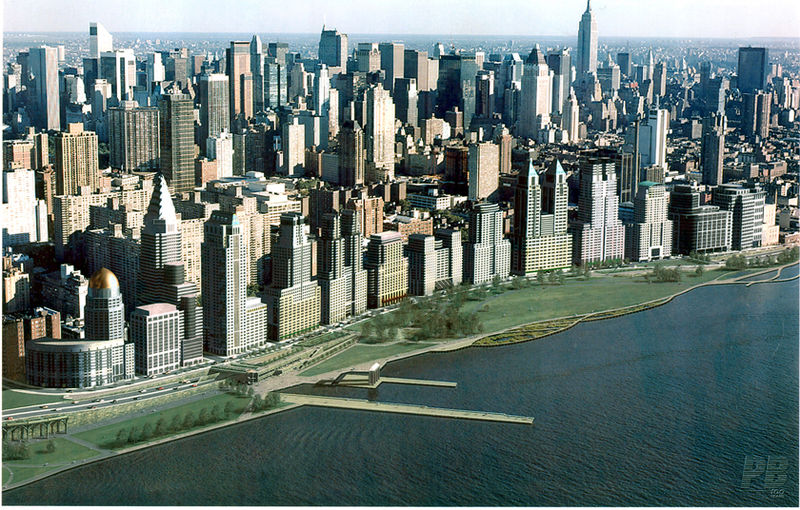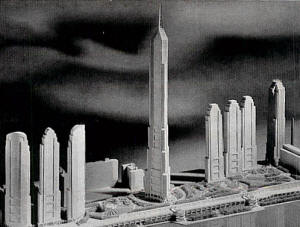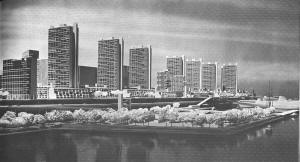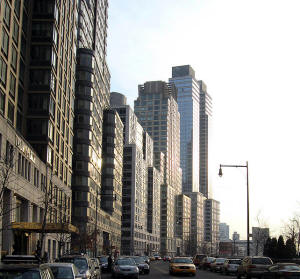| New York
Architecture Images- Recent Riverside South-Trump Place |
|
| Please note- I do not own the copyright for the images on this page. | |
|
architect |
Various |
|
location |
56-acre (230,000 m2) site between 59th Street and 72nd Street |
|
date |
Various |
|
style |
Neomodern architecture |
|
type |
Apartment Building |
|
construction |
The $3 billion project on a 56-acre (230,000 m2) site was to include 16 apartment buildings with a maximum of 5,700 residential units, 1,800,000 square feet (167,000 m2) of studio space, 300,000 square feet (30,000 m2) of office space, ancillary retail space and a 25-acre (100,000 m2) waterfront park. |
 |
|
   |
|
|
notes |
Riverside South (also known as Trump Place) is an apartment
complex originated by Donald Trump and six civic partners (Municipal Art
Society, Natural Resources Defense Council, New Yorkers for Parks, Regional
Plan Association, Riverside Park Fund, and Westpride) on the Upper West Side
of Manhattan, in New York City. The $3 billion project on a 56-acre (230,000 m2) site between 59th Street and 72nd Street was to include 16 apartment buildings with a maximum of 5,700 residential units, 1,800,000 square feet (167,000 m2) of studio space, 300,000 square feet (30,000 m2) of office space, ancillary retail space and a 25-acre (100,000 m2) waterfront park. The studio and office space were not approved. Nevertheless, Riverside South is the biggest privately-developed complex currently being built in New York City. The land for the development was formerly a freight rail yard owned by the New York Central Railroad. New York Central's rail track north of 72nd Street was covered in the 1930s in a Robert Moses project called the West Side Improvement. The project was bigger than Hoover Dam and created the Henry Hudson Parkway. It also created Riverside Park and was so skillfully done that many believe the park and road are set on a natural slope. New York Central merged with the Pennsylvania Railroad to form Penn Central in 1968 as the rail lines were suffering severe financial difficulties that would ultimately lead to the demise of both. The rail yard was known as the Penn Yards even though Penn Central only owned it for a brief period. In 1962 the railroad proposed a partnership with the Amalgamated Lithographers Union to build a mixed-use development with 12,000 apartments, Litho City, on a platform over the tracks and on landfill in the Hudson River. The late 1960s saw various proposals by the city's Educational Construction Fund for mixed residential and school projects, also partly on landfill. As the railroad as well as the city faced bankruptcy, Donald Trump first optioned the property for $10 million in 1974. His proposal for 12,450 apartments depended on public financing, which never materialized. The Macri Group, an Argentine company, bought the property in partnership with developer Abe Hirschfeld in 1979, and in 1981, for the first time, a redevelopment plan was approved for the site — a 7.3 million square-foot, largely residential project named Lincoln West. However, the development team was unable to obtain financing, and the project died. In January 1985, Donald Trump bought the rights of the Macri Group for $117 million. Trump proposed building a vast complex he called Television City, featuring headquarters for NBC along with television studios. The plan involved 18.5 million square feet of residential, retail, office, and studio construction. The centerpiece of the project, designed by Helmut Jahn, was to be a 152-story tower, the "World's Tallest Building." The project generated fierce opposition and NBC, fearing delays, eventually decided to continue broadcasting from Rockefeller Center. At this point the project was redesigned by Alexander Cooper, renamed Trump City, and downsized slightly to 14.5 million square feet, but that failed to satisfy the critics. In 1989 six civic organizations proposed an alternative, known as Riverside South — a largely residential project of 7.3 million square feet, the previously approved floor area, based on relocating, and partially burying the West Side Highway to make room for a 23-acre (93,000 m2) expansion of Riverside Park. Hobbled by his weak financial position, Trump acquiesced and formed a partnership with his critics, formally the Riverside South Planning Corporation (RSPC). The RSPC compromise project was approved in 1992 without the television studios and office space that Trump had substituted for some of the residential space. The final project size was 6.1 million square feet with 1.8 million square feet of television studios still possible on the two southern blocks.  Riverside South civic alternative As Trump faced bankruptcy in the early 1990s, he was forced to take on a group of Hong Kong investors as partners, but he remained as the public face of the group, as he has on many other projects that have his name but which he does not control. Construction was delayed for several years as the new investors unsuccessfully sought public financing. With improvement in the development climate, the new investors began construction in 1997. In 2005, the Hong Kong investors sold the unbuilt portion of the property to the Carlyle Group and the Extell Development Company. Contending that the sale for $1.76 billion was little more than half what the property was worth, Trump sued his partners, but lost. Trump's name remains on some of the existing buildings. In late 2008 Extell proposed a 2.9 million square-foot, largely residential project on the southern two blocks (59th to 61st streets) to complete the development (up from 2.4 million square feet — the 1.8 million square feet of studio space plus 600,000 square feet of residential space already approved). The Extell project, known as Riverside Center, is currently undergoing final review. One of the key components of Riverside South is relocating and burying the West Side Highway from approximately West 70th Street to West 61st Street. The current viaduct is the only remaining section of the elevated highway which once extended to the southern tip of Manhattan. A portion of the elevated highway, which was mostly built in the 1920s and 1930s, collapsed in 1973 at 14th Street. Rather than repairing the antiquated road, the state closed it and planned to replace the viaduct (up to 34th Street) with an interstate highway in new landfill, known as Westway. Fifteen years later, after the failure of the Westway proposal, the state settled on an at-grade boulevard up to 57th Street flanked by a new Hudson River Park. Despite Robert Moses' proposal to relocate the highway to grade north of 59th Street to facilitate an extension of Riverside Park, the elevated section between 59th and 72nd streets remained. The section between 59th and 72nd streets was a little thornier than the rest because, while the state owned an easement, neither the state nor the city owned the land. Acquiring the land to relocate the highway from the bankrupt Penn Central would have interfered with private development, which was seen at a time when the City was also near bankruptcy, as preferable to public financing (See History of New York City (1946-1977)). Street view of Riverside South buildingsDespite city approval in 1992 of the Riverside South plan, which would create a public park with private funds, opponents claim that any complementary public funding to bury the road would benefit only the developer and effectively waste the public funds used to renovate the viaduct in the 1990s. Opponents are further upset by the decision to close the West 72nd Street entrance ramp to the West Side Highway. However, in June, 2006, the developer began construction of a tunnel for the north-bound relocated highway between 61st and 65th streets, raising hopes that the highway will eventually be moved. The second phase of Riverside South is projected to be completed soon. Overall, the project will consist of sixteen apartment buildings, condominiums, and lease properties. As of mid-2010, twelve buildings would have been scheduled for completion; most have been rented out or sold as of December 2009. As with all dwellings bearing the Trump name, living units in Riverside South are likely to be positioned towards the high-end housing market. Nevertheless, 12% to 20% of the units will be affordable, as required by the City Planning Commission approval of the project. |
|
|
|